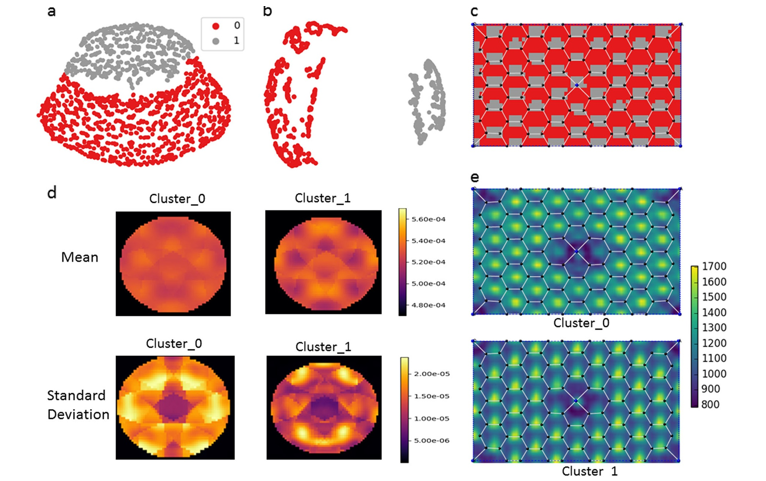 Manifold learning of four-dimensional scanning transmission electron microscopy (四维扫描透射电子显微镜的多维学习)
Manifold learning of four-dimensional scanning transmission electron microscopy (四维扫描透射电子显微镜的多维学习)
Xin Li, Ondrej E. Dyck, Mark P. Oxley, Andrew R. Lupini, Leland McInnes, John Healy, Stephen Jesse & Sergei V. Kalinin
npj Computational Materials 5:5 (2019)
doi:s41524-018-0139-y
Published online:07 January 2019
Abstract| Full Text | PDF OPEN
摘要:显示局部原子衍射图的四维扫描透射电子显微镜(4D-STEM)正在成为探测原子结构和原子电场复杂细节的有力技术。然而,大量数据的有效处理和解释仍然具有挑战性,特别是对于二维或轻质材料,因为记录在像素化阵列上的衍射信号很弱。本研究采用数据驱动的多维学习方法,对4D-STEM数据集进行直观的可视化和探索分析,从像素化探测器上记录的具有单一掺杂原子的单层石墨烯中提取原子分辨偏转模式的实空间相邻效应。这些提取的图案涉及单个原子位置和子晶格结构,通过多模式视图有效地区分单个掺杂剂的异常。我们相信使用多维学习分析将加速物理学新发现,这些新发现会将铁电、拓扑自旋和范德华异质结等材料与数据丰富的成像机制联系起来。
Abstract:Four-dimensional scanning transmission electron microscopy (4D-STEM) of local atomic diffraction patterns is emerging as a powerful technique for probing intricate details of atomic structure and atomic electric fields. However, efficient processing and interpretation of large volumes of data remain challenging, especially for two-dimensional or light materials because the diffraction signal recorded on the pixelated arrays is weak. Here we employ data-driven manifold learning approaches for straightforward visualization and exploration analysis of 4D-STEM datasets, distilling real-space neighboring effects on atomically resolved deflection patterns from single-layer graphene, with single dopant atoms, as recorded on a pixelated detector. These extracted patterns relate to both individual atom sites and sublattice structures, effectively discriminating single dopant anomalies via multi-mode views. We believe manifold learning analysis will accelerate physics discoveries coupled between data-rich imaging mechanisms and materials such as ferroelectric, topological spin, and van der Waals heterostructures.
Editorial Summary
Artificial intelligence: getting more from microscopy images (人工智能:从显微图像中获取更多信息)
自动算法可以提取隐藏在高分辨率显微镜图像中的材料原子细节信息。由美国橡树岭国家实验室的Sergei V. Kalinin(本刊副主编)领导的国际团队,使用计算机协议进行数据分析(他们将该方法称为多维学习, manifoold learning),通过电子束照射石墨烯的超薄层来收集大量图像中的周期性特征。然后,计算机自动将这些特征与原子相对位置有关的信息链接。该技术不仅可用于识别可能引起异常光电或磁性能的材料局部结构变化,而且还可用来探索生成这些图像的实验条件如何进一步改善,以从高分辨显微技术中获得最多信息。
Automatic algorithms can extract information on the atomic details of materials hidden in high-resolution microscopy images. An international team led by Sergei V. Kalinin at the Oak Ridge National Laboratory, USA, use a computer protocol for data analysis, called manifold learning, to find recurrent features in a large set of images collected by illuminating an ultrathin layer of graphene with a beam of electrons. Then, the computer automatically linked such features to information related to the relative position of the atoms. This technique may be used not only to identify local changes in the material structure that may be responsible for unusual optoelectronic or magnetic properties, but also to understand how the experimental conditions used to generate these images can be further improved to obtain the most from high-resolution microscopy techniques.


 沪公网安备 31010502006565号
沪公网安备 31010502006565号